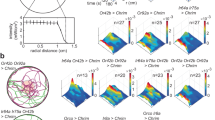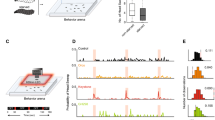Summary
Drosophila melanogaster is able to perform osmotropotaxis under open-loop conditions. With an ‘optimal’ stimulus the average turning tendency to the side of higher concentration corresponds to a circular track with radiusr=0.8 cm. The response amplitude does not decrease within 1 or 2 h. Unilaterally antennectomized flies in an homogeneous odor field show a permanent turning tendency towards their intact side.
The smallest concentration ratio to elicit osmotropotaxis in normal flies ranges between 6∶10 and 9∶10 at high and between 2∶10 and 5∶10 at an about 50 times lower odor intensity. No negative tropotaxis (i.e. turning to the side of lower concentration) is observed, even with strong repellents.
Similar content being viewed by others
References
Aceves-Piña EO, Quinn WG (1979) Learning in normal and mutantDrosophila larvae. Science 206:93–96
Buchner E (1976) Elementary movement detectors in an insect visual system. Biol Cybern 24:85–101
Dudai Y (1977) Properties of learning and memory inDrosophila melanogaster. J Comp Physiol 114:69–89
Dudai Y, Yan Y-N, Byers D, Quinn WG, Benzer S (1976) Dunce, a mutant ofDrosophila deficient in learning. Proc Natl Acad Sci USA 73:1684–1688
Ekman G, Berglund B, Berglund U, Lindvall T (1967) Perceived intensity of odor as a function of time of adaptation. Scand J Psychol 8:177–186
Engen T (1971) Olfactory psychophysics. In: Beidler LM (ed) Handbook of sensory physiology, vol 4. Springer, Berlin Heidelberg New York, pp 216–244
Fischbach KF (1979) Influence of homogeneously applied olfactory stimuli on phototaxis ofDrosophila melanogaster. In: Gilles R (ed) Animals and environmental fitness (Abstracts). Pergamon Press, Oxford New York Toronto Sydney Paris Frankfurt, pp 91–92
Flügge Ch (1934) Geruchliche Raumorientierung vonDrosophila melanogaster. Z Vergl Physiol 20:463–500
Fukushi T (1979) Properties of olfactory conditioning in the housefly,Musca domestica. J Insect Physiol 25:155–159
Götz KG (1975) Hirnforschung am Navigationssystem der Fliegen. Naturwissenschaften 62:468–475
Götz KG, Wenking H (1973) Visual control of locomotion in the walking fruitflyDrosophila. J Comp Physiol 85:235–266
Hangartner W (1967) Spezifität und Inaktivierung des Spurphero- mons vonLasius fuliginosus Latr. und Orientierung der Arbeiterinnen im Duftfeld. Z Vergl Physiol 57:103–136
Heisenberg M (1980) Mutants of brain structure and function: what is the significance of the mushroom bodies for behavior? In: Siddiqi O, Babu P, Hall LM, Hall J (eds) Development and Biology ofDrosophila. Plenum Press, New York London, pp 373–390
Kellog FE, Frizel DE, Wright RH (1962) The olfactory guidance of flying insects. 4.Drosophila. Can Entomol 94:884–888
Kikuchi T (1973) Genetic alteration of olfactory functions inDrosophila melanogaster. Jpn J Gen 48:105–118
Kühn A (1919) Die Orientierung der Tiere im Raum. Fischer, Jena
Kramer E (1976) The orientation of walking honey-bees in odour fields with small concentration gradients. Physiol Entomol 1:27–37
Lob J (1913) Die Tropismen. In: Winterstein H (ed) Handbuch der vergleichenden Physiologie, Bd 4. Fischer, Jena, pp 451–511
Martin H (1965) Osmotropotaxis in the honey-bee. Nature 208:59–63
Masuhr T, Menzel R (1972) Learning experiments on the use of side-specific information in the olfactory and visual system in the honey-bee (Apis melliferd). In: Wehner R (ed) Information processing in the visual system of arthropods. Springer, Berlin Heidelberg New York, pp 315–321
Otto E (1951) Untersuchungen zur Frage der geruchlichen Orientierung bei Insekten. Zool Jahrb Allg Zool Physiol 62:65–92
Preiss R (1980) Anemotaxis im Lauf und Flug beim Schwammspinner. Versuche zur Aufklärung des Wirkungsgefüges. Doctoral thesis, L.M. Universität, München
Quinn WG, Harris WA, Benzer S (1974) Conditioned behavior inDrosophila melanogaster. Proc Natl Acad Sci USA 71:708–712
Rodrigues V, Siddiqi O (1978) Genetic analysis of chemosensory pathway. Proc Indiana Acad Sci 87:147–160
Schöne H (1980) Orientierung im Raum. Wissenschaftliche Verlagsgesellschaft, Stuttgart, pp 64
Tompkins L, Hall J, Hall LM (1980) Courtship-stimulating volatile compounds from normal and mutantDrosophila. J Insect Physiol 26:689–697
Traynier RMM (1968) Sex attraction in the mediterranean floor mothAnagasta kühniella: location of the female by the male. Can Entomol 100:5–10
Author information
Authors and Affiliations
Rights and permissions
About this article
Cite this article
Borst, A., Heisenberg, M. Osmotropotaxis inDrosophila melanogaster . J. Comp. Physiol. 147, 479–484 (1982). https://doi.org/10.1007/BF00612013
Accepted:
Issue Date:
DOI: https://doi.org/10.1007/BF00612013




